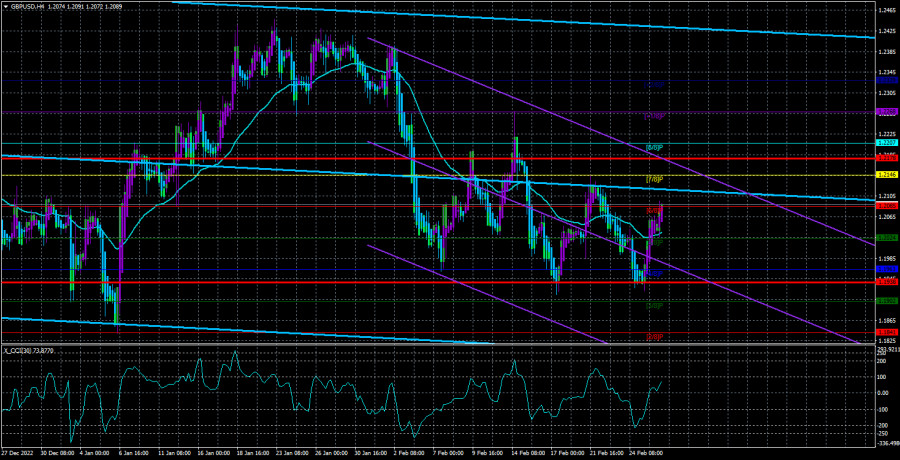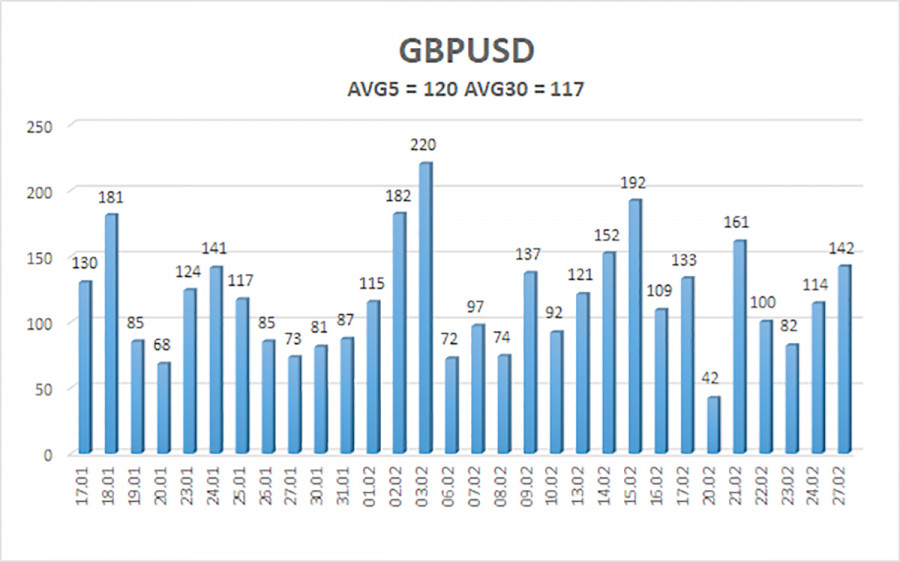

The macroeconomic statistics released by the US on Monday and the pattern of the pair's movement in previous weeks both contributed to the strong increase in the GBP/USD currency pair on Monday. We've already mentioned that the 24-hour TF has a 500-point-wide side channel. The pair has been unable to leave it for three months at this point. Its lower limit is at the level of 1.1840, but as we can see, bears also encounter some challenges when trying to pass the level of 1.1940. Three recent attempts to consolidate below have all failed. This behavior causes a "swing" in a 4-hour time frame. The price consistently deviates from the moving average line's direction of movement. We don't rule out the possibility that the pair could increase by 300 points at this moment as a new round of upward movement within the side channel on the 24-hour TF begins.
Concerning Monday's macroeconomic statistics in the US, it is important to remember that there was only one report. Absolutely, and it's one that traders have neglected a lot lately. Yesterday, however, was an exception, and we witnessed a rather significant decline in the dollar after news of a significant decrease in orders for long-term commodities surfaced. Yet, we think the pair would have grown even without this report. As a result, the price is currently above the moving average, but this has no significance. It could already drop to a level of 1.1940 or so today. The "swing" is difficult since it is very challenging to anticipate the movement. Moreover, there is now absolutely no essential background. There won't be anything for traders to react to during the day.
The "Northern Ireland Protocol" agreement has finally been reached after much anticipation.
I want to make it clear right now that neither the pound nor the euro is particularly affected by this transaction. This news may help both European currencies in the short term, but it is unlikely to have a lasting impact. For now, market participants should pay attention to central bank rates, inflation, the recession, and the language of the Fed and BA representatives. After a year of negotiations, London and Brussels have come to an agreement, which amounts to nothing more than a new episode of the "Brexit" series. Therefore, the so-called "red" and "green" routes for the movement of goods have been agreed upon by the European Union and the United Kingdom; British legislation regarding VAT and excise duties will also be in effect in Northern Ireland; medicines that have been approved by the British Ministry of Health will be available in all pharmacies and hospitals in Northern Ireland; and agreements have also been reached regarding several legal procedures for Northern Ireland.
The new agreement has already been called "a breakthrough that will secure uninterrupted trade throughout the Kingdom and safeguard the sovereignty of Northern Ireland" by British Prime Minister Rishi Sunak. Additionally, he said that the new agreement keeps the 1998 Belfast Agreement in effect while also resolving nearly all of the issues that the people of Northern Ireland faced. As London was going to implement the 16th article of the Brexit agreement last year, which permits not complying with several other terms and could severely worsen relations between London and Brussels, Britain now has one less issue. Even if rejoining the EU at this time is not an option, the incoming British government wants to change the direction of rapprochement. But, as was already mentioned, the majority of Britons now regret that their nation left the Alliance. Rishi Sunak even referred to the 2016 referendum as a "mistake" and pledged to use all available means to reestablish ties between Europe and the United Kingdom.
Yet, as previously stated, the monetary policy of the Fed and the BA is now more crucial. The British regulator has started to show hints in the past week that it plans to maintain raising the rate at the same rate, and it is this development that may prevent the pound from falling once again. Keep in mind that the euro is currently forming a full-fledged downward correction, and the pound is declining quite reluctantly. The market does not yet completely understand what to expect from the British regulator because the ECB's upcoming judgments have already been determined and BA has not yet made its conclusions for the next three meetings.

Over the previous five trading days, the GBP/USD pair has averaged 120 points of volatility. This value is "high" for the dollar/pound exchange rate. So, on Tuesday, February 28, we anticipate movement that is contained inside the channel and is limited by levels 1.1938 and 1.2178. A new round of downward movement is indicated by the Heiken Ashi indicator turning downward.
Nearest levels of support
S1 – 1.2024
S2 – 1.1963
S3 – 1.1902
Nearest levels of resistance levels that are closest:
R1 – 1.2085
R2 – 1.2146
R3 – 1.2207
Trade Suggestions:
In the 4-hour timeframe, the GBP/USD pair once more consolidated above the moving average. Consequently, until the Heiken Ashi signal turns down, it is still possible to hold long positions with targets of 1.2146 and 1.2178. In the event of consolidation below the moving average, short positions may be initiated with targets of 1.1963 and 1.1938.
explanations for the illustrations:
Channels for linear regression - allow us to identify the present trend. The trend is now strong if they are both moving in the same direction.
Moving average line (settings 20.0, smoothed): This indicator identifies the current short-term trend and the trading direction.
Murray levels serve as the starting point for adjustments and movements.
Based on current volatility indicators, volatility levels (red lines) represent the expected price channel in which the pair will trade the following day.
A trend reversal in the opposite direction is imminent when the CCI indicator crosses into the overbought (above +250) or oversold (below -250) zones.